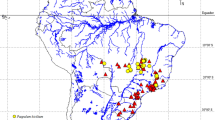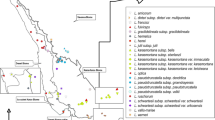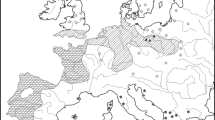Abstract
Francis (1979) proposed that clonal and solitary forms of the anemone Anthopleura elegantissima are actually two species. In 1984 and 1985, samples from two to six California populations of all known forms and species of California Anthopleura were analyzed electrophoretically to determine their taxonomic relationships. Data from 14 enzymes and 18 loci, 17 of them polymorphic, show that the two forms of A. elegantissima are virtually identical electrophoretically, and there is no evidence of reduced gene flow between them. We conclude there are three species of Anthopleura in California: A. elegantissima (Brandt, 1835), A. xanthogrammica (Brandt, 1835) and A. artemisia (Dana, 1848). Genetic variation in the two species capable of asexual reproduction, A. elegantissima and A. artemisia, is extremely high, approximately 2.5 times that of the strictly sexual A. xanthogrammica.
Similar content being viewed by others
Literature cited
Avise, J. C.: Systematic value of electrophoretic data. Syst. Zool. 23, 465–481 (1975)
Ayala, F. J.: Enzymes as taxonomic characters. In Protein polymorphism: adaptative and taxonomic significance, pp 3–26. Ed. by G. S. Oxford and D. Rollinson. New York: Academic Press 1983
Ayala, F. J., D. Hedgecock, G. S. Zumwalt and J. W. Valentine: Genetic variation in Tridacna maxima, an ecological analog of some unsuccessful evolutionary lineages. Evolution 27, 177–191 (1973)
Ayre, D. J.: The effects of sexual and asexual reproduction on geographic variation in the sea anemone Actinia tenebrosa. Oecologia 62, 222–229 (1984)
Berger, P. J.: Population genetics of marine gastropods and bivalves. In: The Mollusca, Vol. 6, pp 563–596. Ed. by W. D. Russell-Hunter. New York: Academic Press 1983
Berggren, W. A.: Roles of ocean gateways in climatic changes. In: Studies in geophysics, pp 118–125. Washington D.C.: National Academy Press 1982
Brandt, J. F.: Prodromus descriptionis animalium ab H. Mertensio observatorum, Akademiia nauk, Leningrad, pp 201–275. Recueil des actes de la seance publique de l'academie impériale des sciences de St. Petersbourg 1835
Brewer, G. J.: An introduction to isozyme techniques, 186 pp. New York: Academic Press 1970
Bucklin, A. and D. Hedgecock: Biochemical genetic evidence for a third species of Metridium senile. Mar. Biol. 66, 1–7 (1982)
Bucklin, A., D. Hedgecock and C. Hand: Genetic evidence of self-fertilization in the sea anemone Epiactis prolifera. Mar. Biol. 84, 175–182 (1984)
Carlgren, O.: A survey of the Phytodactiaria, Corallimorpharia and Actiniaria. K. Sven. Vetenskapsakad. Handl. ser. 4, 1, 1–121 (1949)
Carlgren, O.: The Actinian fauna of the Gulf of California. U.S. natl Mus. 101, 415–449 (1951)
Cook, R. E.: Clonal plant populations. Am. Sci. 71, 244–253 (1983)
Dana, J. D.: Zoophytes. United States exploring expedition during the years 1838–42, Vol. 7, with atlas. Philadelphia 1848
Druffel, E. M.: Banded corals: changes in oceanic carbon-14 during the Little Ice Age. Science, Wash. D.C. 218, 13–19 (1982)
Dunn, D. W.: Anthopleura handii n. sp. (Coelenterata, Actinaria) an internally brooding, intertidal sea anemone from Malaysia. Wasmann J. Biol. 35, 54–64 (1977)
Ferguson, A.: Biochemical systematics and evolution, 170 pp. London: Blackie Press 1980
Foltz, D. W.: Null alleles as a possible cause of heterozygote deficiencies in the oyster Crassostrea virginica and other bivalves. Evolution 40, 211–215 (1986)
Ford, C. E.: Reproduction in the aggregating sea anemone Anthopleura elegantissima. Pac. Sci. 18, 138–145 (1964)
Francis, L.: Clone specific segregation in the sea anemone Anthopleura elegantissima. Biol. Bull. mar. biol. Lab., Woods Hole 144, 64–72 (1973a)
Francis, L.: Intraspecific aggression and its effects on the distribution of Anthopleura elegantissima and some related sea anemones. Biol. Bull. mar. biol. Lab., Woods Hole 144, 73–92 (1973b)
Francis, L.: Contrast between solitary and clonal lifestyles in the sea anemone Anthopleura elegantissima. Am. Zool. 19, 669–681 (1979)
Garton, D. W.: Relationship between multiple locus heterozygosity and physiological energetics of growth in the estuarine gastropod Thais haemastoma. Physiol. Zool. 57, 530–543 (1984)
Hamrick, J. L.: Genetic variation and longevity. In: Topics in plant population biology, pp 84–107. Ed. by O. T. Solbrig, S. Jain, G. B. Johnson and P. H. Ravens. New York: Columbia University Press 1979
Hamrick, J. L., Y. B. Linhart and J. B. Mitton: Relationships between life history characteristics and electrophoretically detectable genetic variation in plants. A. Rev. Ecol. Syst. 10, 173–200 (1979)
Hand, C.: The sea anemones of central California, Part II. Wasman J. Biol. 13, 37–99 (1955)
Harris, H. and D. A. Hopkinson: Handbook of enzyme electrophoresis in human genetics, 259 pp. New York: American Elsevier 1976
Hartl, D. L.: Principles of population genetics, 488 pp. Sunderland, Massachusetts: Sinauer Associates 1980
Hiebert, R. D.: The population biology of bristlecone pine in the eastern Great Basin. University of Kansas: Ph.D. dissertation 1977
Hoffmann, R. J.: Variation in contributions of asexual reproduction to the genetic structure of populations of the sea anemone Metridium senile. Evolution 40, 357–365 (1986)
Jennison, B. L.: Gametogenesis and reproductive cycles in the sea anemone Anthopleura elegantissima. Can. J. Zool. 57, 403–411 (1979)
Koehn, R. K. and P. M. Gaffney: Genetic heterozygosity and growth rate in Mytilus edulis. Mar. Biol. 82, 1–7 (1984)
Levin, D. A.: Some genetic consequences of being a plant. In: Ecological genetics: the interface, pp 189–212. Ed. by P. F. Brussard. New York: Springer-Verlag 1978
MacGinitie, G. E. and N. MacGinitie: Natural history of marine animals, 523 pp. New York: McGraw Hill 1968
Mallet, A. L., E. Zouros, K. E. Gartner-Kepkay, K. R. Freeman and L. M. Dickie: Larval viability and heterozygote deficiency in populations of marine bivalves: evidence from pair matings in mussels. Mar. Biol. 87, 165–172 (1985)
Morris, R. H., D. P. Abbott and E. C. Haderlie: Intertidal invertebrates of California, 690 pp. Stanford, California: Stanford University Press 1980
Nei, M.: Genetic distances between populations. Am. Nat. 106, 283–292 (1972)
Nei, M. and A. K. Roychoudhury: Sample variances of heterozygosity and genetic distance. Genetics 76, 379–390 (1974)
Nevo, E., A. Beiles and R. Ben-Shlomo: The evolutionary significance of genetic diversity: ecological, demographic and life history correlates. Lect. Notes Biomath. 53, 13–213 (1984)
Newman, W. A.: California Transition Zone: significance of short-range endemics. In: Historical biogeography, plate tectonics and the changing environment, pp 399–416. Ed. by J. Gray and A. J. Boucot. Corvallis, Oregon: Oregon State University Press 1979
Nozaki, Y., D. M. Rye, K. K. Turekian and R. E. Dodge: A 200 year record of carbon-13 and carbon-14 variations in a Bermuda coral. Geophys. Res. Lett. 5, 825–828 (1978)
Potts, D. C.: Generation times and the Quaternary evolution of reef-building corals. Paleobiology 10, 48–58 (1984)
Potts, D. C., T. J. Done, P. J. Isdale and D. A. Fisk: Dominance of a coral community by the genus Porites (Scleractinia). Mar. Ecol. Prog. Ser. 23, 79–84 (1985)
Poulik, M. D.: Starch gel electrophoresis in a discontinuous system of buffers. Nature, Lond. 180, 1477–1479 (1957)
Ricketts, F. F. and J. Calvin: Between Pacific tides, 4th ed., 614 pp. Stanford, California: Stanford University Press 1968
Sebens, K. P.: Reproductive ecology of the intertidal sea anemones Anthopleura xanthogrammica and Anthopleura elegantissima: body size, habitat and sexual reproduction. J. exp. mar. Biol. Ecol. 54, 225–250 (1981)
Sebens, K. P.: Asexual reproduction in Anthopleura elegantissima: seasonality and spatial extent of clones. Ecology 63, 434–444 (1982)
Shaw, C. R. and R. Prasad: Starch gel electrophoresis of enzymes —a compilation of recipes. Biochem. Gen. 4, 297–320 (1970)
Shick, J. M. and A. N. Lamb: Asexual reproduction and genetic population structure in the colonizing sea anemone Haliplanella luciae. Biol. Bull. mar. biol. Lab., Woods Hole 153, 604–617 (1977)
Siebert, A. E.: A description of the embryology, larval development and feeding of the sea anemones, Anthopleura elegantissima and Anthopleura xanthogrammica. Can. J. Zool. 52, 1383–1388 (1974)
Smith, B. L.: Taxonomy and population genetics of the sea anemone genus Anthopleura in California. University of California at Santa Cruz: M.S. thesis 1986
Sneath, P. H. A. and R. R. Sokal: Numerical taxonomy, 573 pp. San Francisco: Freeman and Co. 1973
Sole-Cava, A. M., J. P. Thorpe and J. G. Kaye: Reproductive isolation with little genetic divergence between Urticina felina and U. eques. Mar. Biol. 85, 279–284 (1985)
Thorpe, J. P.: Enzyme variation, genetic distance and evolutionary divergence in relation to levels of taxonomic separation. In: Protein polymorphism: adaptive and taxonomic significance, pp 131–152. Ed. by G. S. Oxford and D. Rollinson. New York: Academic Press 1983
Tracey, M. L., K. Nelson, D. Hedgecock, R. A. Shleser and M. L. Pressick: Biochemical genetics of lobsters (Homarus): genetic variation and the structure of American lobster populations. J. Fish. Res. Bd Can. 33, 1108–1119 (1975)
Valentine, J. W.: Numerical analysis of marine molluscan ranges on the extratropical northeastern Pacific shelf. Limnol. Oceanogr. 2, 246–255 (1966)
Vasek, F. C.: Creosote Bush, long-lived clones in the Mojave Desert. Am. J. Bot. 67, 246–255 (1980)
Verrill, A. E.: Notes on the Radiata in the museum of Yale College, with descriptions of new genera and species. Trans. Connecticut Acad. Arts Sci. 1, 247–596 (1869)
Wright, S.: Evolution and the genetics of populations, Vol. 4. Variability within and among natural populations, 579 pp. Chicago: University of Chicago Press 1978
Zouros, E. and D. W. Foltz: Possible explanations of heterozygote deficiency in bivalve molluscs. Malacologia 25, 583–591 (1984)
Zouros, E., S. M. Singh and H. E. Miles: Growth rate in oysters: an overdominant phenotype and its possible explanations. Evolution 34, 856–867 (1980)
Author information
Authors and Affiliations
Additional information
Communicated by J. P. Grassle, Woods Hole
Rights and permissions
About this article
Cite this article
Smith, B.L., Potts, D.C. Clonal and solitary anemones (Anthopleura) of western North America: population genetics and systematics. Mar. Biol. 94, 537–546 (1987). https://doi.org/10.1007/BF00431400
Accepted:
Issue Date:
DOI: https://doi.org/10.1007/BF00431400




